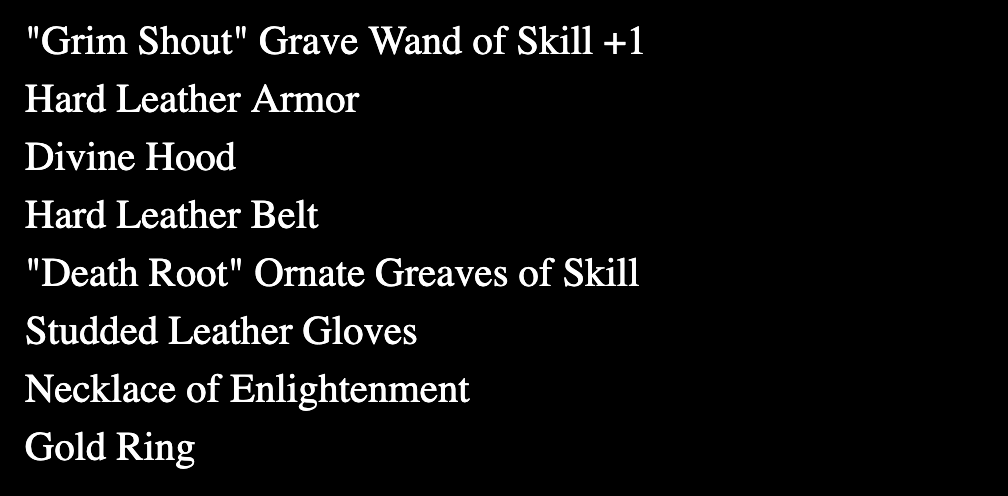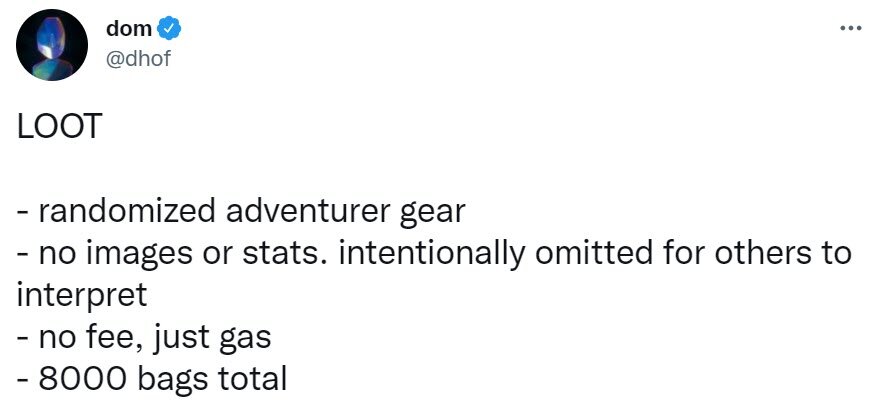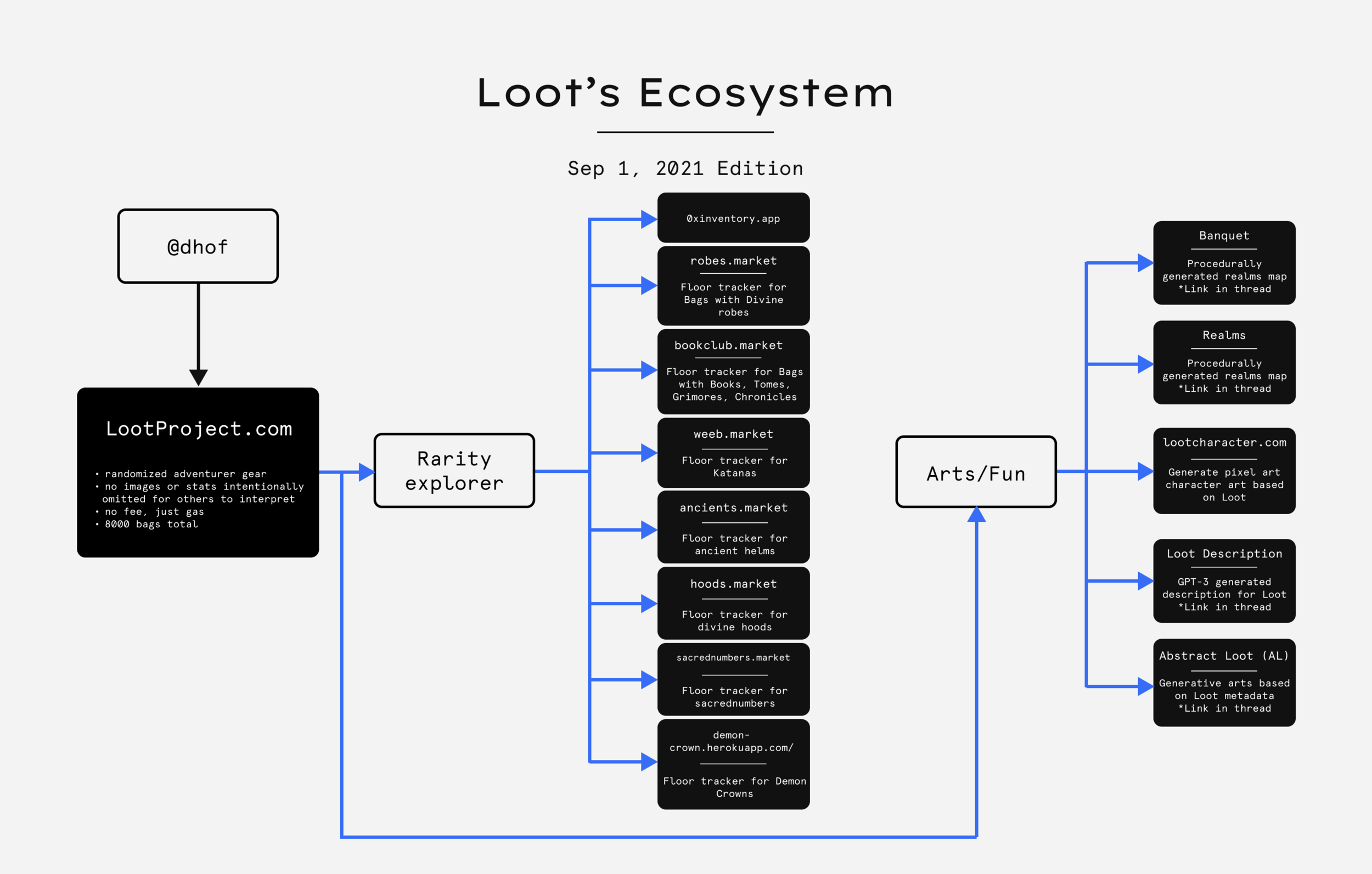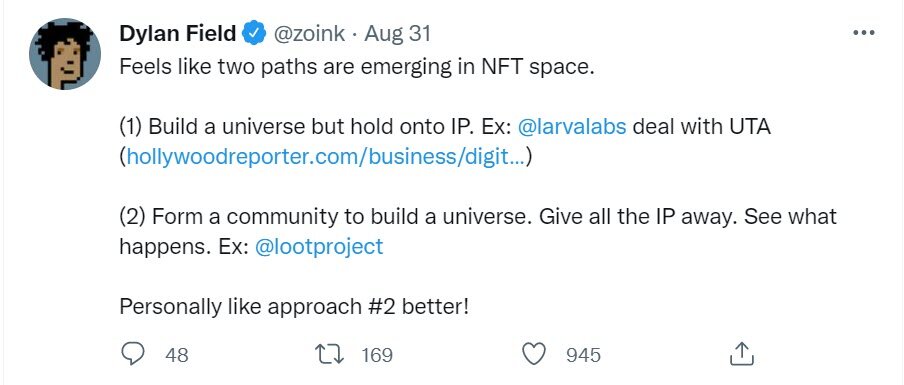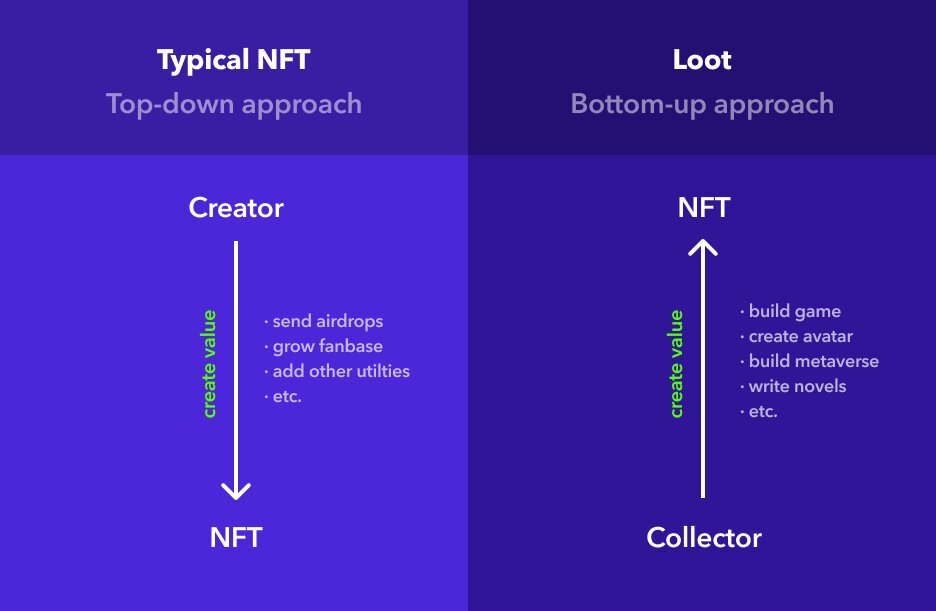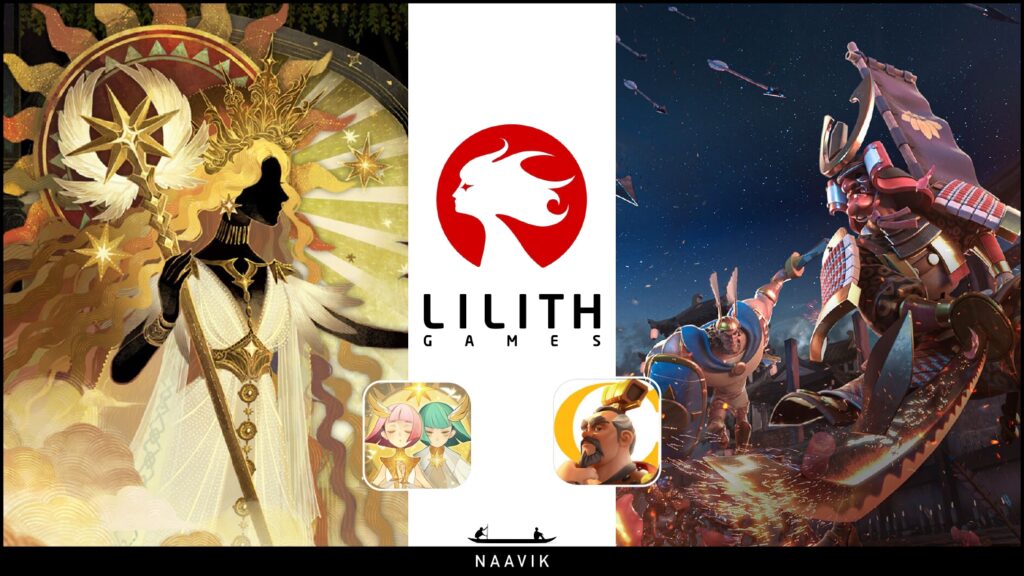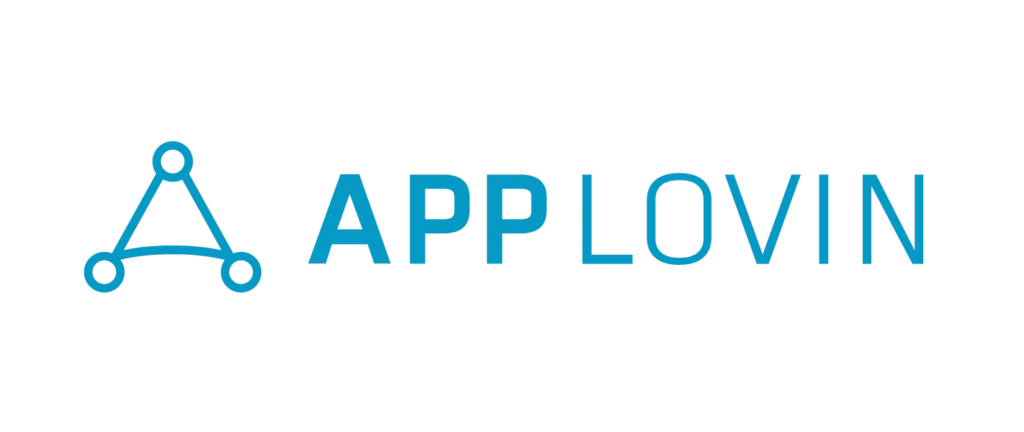Hi Everyone! Welcome back to another issue. As always, please consider forwarding Master The Meta to your colleagues, friends, and work acquaintances who might also find this content valuable. We’d appreciate it!
Naavik Exclusive: Roundtable #13
In this Metacast episode, Abhimanyu Kumar, Matej Lancaric, and Anton Gorodetsky are joined by host Nicolas Vereecke to discuss:
- Netflix’s baby steps into gaming
- Apple’s loosening of its App Store rules
- China’s ban of more than three hours of gaming per week for minors
As always, you can find us on Spotify, Apple Podcasts, Google Podcasts, our website, or anywhere else you listen to podcasts. Also, remember to shoot us any questions here.
#1: Loot Makes Waves
Source: Twitter
There seems to be a new crazy crypto project every single day.
This week saw the launch of Loot, which, to put it one way, is just a collection of 8000 images. To put it another way, it’s an ever-evolving game that has grown into something much bigger than its modest roots. Loot as a community-operated and on-chain initiative is important to understand because of the impact it might have on game development, IP, and existing publishing models. While the topic has been extensively covered by Crypto Twitter, Kyle Russell, Casey Newton, and many others, I’d like to cover a bit of the gaming side. Let's start with a quick summary of the project and dive deeper into the relevant aspects to gaming.
What is Loot?
Source: Twitter
Loot is an algorithmically generated set of 8000 SVG images representing eight different adventure-themed items. Loot also randomly distributes scarcity into each of its items: weapons, chest armor, head armor, waist armor, foot armor, hand armor, necklaces, and rings that can each be common, uncommon, rare, epic, legendary or mythic.
Source: Twitter
Loot's abstract, interpretative approach of eight words gives people the space to get funky and creative with what they build. Because it’s on-chain, the source code is available to build off of, to change, or to copy completely. There are no right or wrong things to build. All that matters is that people use it and creators continue to build, fork, and remix the burgeoning projects.
Why is Loot Relevant to Gaming?
In many ways, Loot feels like the internet, MMO version of DnD — choose your own adventure with a bunch of friends and anyone can participate regardless of if they have a genesis Loot NFT or not. Anyone can build anything off of it, and to the extent that people build off what is already built, the project becomes infinitely more expansive.
While Loot is first and foremost a community of NFT holders, take the meta-level and it's also a game. It’s not necessarily like the type of video games we grew up playing, though: there isn’t a UI, there isn’t a set characters to play (per se), there isn’t a story, and there isn’t even a game (yet). More critically, there are no game rules.
The community and game are being built realtime. That’s part of what makes it so interesting.
It’s not a game made by a developer or publisher; rather, it’s a game entirely imagined up and created by the community. Creators can expand the world for the players. Anyone can participate as a creator and anyone can participate as a player. It also has has the potential to bring in thousands of new players as it becomes more consumer-friendly.
What took me a while to wrap my head around is that the game is built into the NFT. Whereas other NFT gaming projects have NFTs as a component of the game, the NFT’s of Loot are the platform and the people who own them the players, creators, beta-testers, modders, remixers. The grassroots, communal nature of this project is perhaps the most potent aspect — so long as someone is building, the project persists. These are the foundations of community-owned NFT gaming.
Source: Twitter
So, what does Loot tell us about the future of games?
- Community-owned NFT Gaming is here to stay
- Publishers will open up their IP to the community in generative ways
- The gaming community will open up to Pay-to-play dynamics
Source: Twitter
Community-Owned NFT Gaming is Here to Stay
Perhaps NFT gaming’s big opportunity lies with community-owned games. What Loot shows us is that the entire corpus — its economics, interface, distribution — of the game lies in the hands of the community. So long as players appreciate its current iteration, they’ll continue to use it, but changing the meta entirely toward new directions also rests in the hands of the community. No matter the changes, value will always find its way back into the hands of the community (and more specifically, into the hands of the community token).
Imagine you’re a participant of a game who stands to earn a lot of money. Doesn’t the incentive structure make it more compelling than a traditional game? Suddenly, the player and the creator can asymmetrically share in the enterprise value of the community-owned project itself; the game is created by the community for the community; and so long as the community stays involved, there are infinite new metas.
In other words, everyone chooses whether to add new components, to build the components on their own, to fork others and to start new projects. The internet — or in this case, Ethereum — becomes the playground — disintermediating the interface layer (game) by stitching together a layer that is co-created by creators and fans both. Loot as spatial software is generative — over time new projects, applications are layered on and on, creating a form of spatial interaction first coordinated over Discord, Twitter, and later as a game.
I believe this grassroots approach is the way to get millions of people using a web3 game. In games, there are only a limited number of people that can participate in a lobby together due to compute limitations. In Loot, there is no cap to the number of players that can participate together. People could be playing a game, building a game, remixing a game, trading currency, etc. The initial Loot release will always be the foundational layer. Over time, the paths might intersect in novel and unexpected ways, and thousands of players will be made aware of one another.
Publishers will Open up their IP to the Community in Generative Ways
Remember the Star Wars Universe? The fact there are infinite galaxies means that there are infinite storylines and infinite timelines, and the interweaving of spatial and temporal creativity can seed all sorts of new adventures, be it fan-made or part of the canon or an offshoot of the canon. The beauty of the Star Wars Universe is that the original movies set the stage for anyone to take part. All that’s left is for Disney to open the IP floodgates to the mass consumer. The same goes for Marvel, Pokemon, you name it.
To cite Kyle Russell: "And assuming the project’s originators went with the direction of the Loot zeitgeist, all of this would be IP that could be re-used and remixed by anyone. That might sounds crazy — isn’t the point to own it, and the point of owning it is to control how it’s used?"
While it may be difficult for publishers like Riot Games to transition their existing games onto the blockchain, there’s an opportunity for them to open up their IP for the community to remix, mod, build. There’s certainly a world where Riot produces 8000 pngs of random characters, attributes, or items and sells them to a core community to produce whatever content the community wants. What might result from a looser control of IP, results in a highly engaged community with creative output.
There’s a reason that publishers like Riot have strict trademarks over their IP, though — brand is their lifeblood. Initiatives like Riot Forge allow them to slowly open the drawbridge of community-based content, with direct input and feedback from the core brand. However, the more the ecosystem expands, the more difficult it becomes for Riot to devote the same attention across its games.
I don’t think the publisher model will ever disappear, but community-owned NFT games are certainly challengers for our time and attention. People are essentially building what they want to see in a game, rather than what publishers want. To the extent that a community participates and remains involved, a grassroots community like Loot will persist.
The Gaming Community Will Open Up to Pay-to-Play Dynamics
In thinking about Loot, I was also reminded of the consumer hype and velvet roping around testflights in consumer social this summer — Poparazzi, BeReal, Dispo are all fascinating apps with use cases built into them that unbundled to some degree Instagram. But NFT shilling and communities feel entirely different.
When someone mints an NFT or shells out significant ETH to buy-in, there's legitimate reason for someone to toot their horn, to talk about the project they’re part of, or to build awareness with their communities.. When people pay-to-play (and importantly, are fine doing so), the dynamics of the game completely change.
Source: Twitter
When a community becomes P2P, churn becomes psychologically difficult after the buy-in. There’s a mindset shift from: “this game or community has a high barrier to entry" to "what can happen once I'm actually in the game and how might we bring more value to it". Having Loot in your ETH wallet sets the stage of involvement in a P2P community, creating more value by allowing people to build, write and create their own stories. P2P means that people have a greater stake in the projects they’re participating in, and thus makes a community more spiritually involved.
There is a paradox of exclusivity in the P2P logic, but Loot has already found a workaround through synthetic loot, where anyone with an Ethereum wallet has a pre-ordained loot, and mloot, an expansion pack of sorts.
What this means is that derivative projects or the builders in the community can choose to program in different types of loot, opening up access to everyone with an Ethereum wallet. While the genesis loot holders may enjoy different types of access or different types of benefit or attributes, other loot holders are given the ability to circumvent the proverbial paywall to participate alongside. A creator can program whatever type of experience they want.
What Does Loot Become?
The short answer is: whatever the community wants it to become.
What started off as an SVG has already become so much bigger. It has the potential to keep expanding. Brian Flynn's 2018 post about Designing Non-Fungible Tokens as Open Ecosystem says it well: "We need to take advantage of what a slow Ethereum blockchain offers to create open ecosystems for non-fungible tokens that centralized counterparts cannot compete with". In other words, Ethereum is about leveraging existing pieces to build upon — composability — and to continue that building. Loot extends this ethos. One branch leads to another or many more. Unlike the centralized approach of companies today, this is a community-led approach. The more that is built by individuals or collectives, the more can be built atop.
There are already so many exciting offshoots of the project already: pixel character generators, rarity trackers, market trackers, generative art, currency, and realms. The community is expanding the universe of eight words of text into a choose your own adventure — expansion packs created daily where millions of ETH wallets holders (or <8000 holders of Loot) can immediately participate together, create stories, and build games. At some level, projects like this will compete on the same level with the biggest IP on engagement and consumer spending. There's even a world where the largest companies release "choose your own adventure packs" and let the community build off existing IP in ways they hadn't allowed previously.
However, the cynic in me worries about what form these communities will take over time.
- Already, it has become extremely difficult to understand what projects are promising. Everyone shills their own communities, and to this end, seemingly non-innovative projects have the ability to rise to the forefront only to be plagued by speculation. Twitter and Discord are chaotic places to be in a lot of the time.
- There’s also significant risk that an early community of skilled builders leave the project as 1) more people join, 2) other remixes and forks become more popular, or 3) the project becomes too unwieldy. Without a good team, it’s hard to build something compelling.
- It’s yet to be seen what effect more people joining will have on a community. Obviously, the goal is to open up access, but the recent mLoot drop actually resulted in is a short-term significant decrease in enterprise value. In gaming, typically the more people playing the better, but will early vocalists and builders be pushed out by influxes?
- Discovery and curation mechanisms in crypto are flawed. There have certainly been an inordinate number of projects that have flopped because some creators don’t necessarily have the same reach as other. But perhaps the serendipity of discovery is also part of the fun.
- A lot of people still seem to care about price, and price only. The people who are “in” benefit but the people who are “out” don’t necessarily. Somehow this needs to be bridged.
That being said, I think we’ll be seeing a lot more of Loot and similar projects. The next generation of games will be community-owned and created, interoperable with one another, expansive, remixed and forked off their predecessors. They’ll also be P2P with the ability to return a player's initial investment through airdrops, expansion packs, P2E, and more.
What does it mean to break apart a community, bring it together and morph it into something coherent, working, grassroots? Where offshoots can happen and not everyone knows what's happening at the same time — but that process of discovery is learned through chatting and building and writing? What happens when a game isn't published top-down and the rules are encoded in by the community?
The seeds have been sown for a larger vision. Dom Hofmann, co-founder of Vine and Loot, is in the process of launching a variety of NFT-based projects that are all seemingly interconnected: Blitmap ("Community crafted sci-fantasy universe), Sugar ("And then, a game."), Supdrive ("On-chain fantasy game console"), and now Loot ("Randomized adventurer gear generated and stored on chain").
Source: Twitter
There's a future in which all these projects come together, expand each other generatively, and interconnect in serendipitous ways. All driven by the community. (Written by Fawzi Itani)
🎮 In Other News…
💸 Funding & Acquisitions:
- Playtika acquired Reworks for $400M (with up to $200M additional incentive). Link
- ProbablyMonsters raised a $200M Series A to build AAA games. Link
- Nifty Games announced a $38M Series B. Link
- Clockwork Labs raised $4.3M for its upcoming MMORPG. Link
- India-based SuperGaming raised a $5.5M Series A. Link
- Thunderful Games acquired Stage Clear Studios for $2.5M. Link
- Studio Sirah announced it had raised $830k for its India-first midcore games. Link
📊 Business:
- South Korea bans Apple and Google monopolies on payments for the App Store and Play Store. Link
- Youtube Gaming signed TimTheTatman and DrLupo. Link
🕹️ Culture & Games:
- Someone (not Nintendo) is bringing Pokemon to the blockchain. Link
- China continues to develop its strict policies against kids playing video games. Link
- FB Gaming opens up a licensed music library to its creators. Link
👾 Miscellaneous Musings:
- “Space Ape Didn’t Miss A Beat”. Link
- "How Shapez.io went from web games to $1M Steam hit”. Link
- “Rethinking The Ban On Selling In-Game Assets”. Link
🔥 Featured Jobs
- Mythical Games: Principal Economy Designer (Remote, US)
- Mythical Games: Lead Product Manger (SF, LA, Seattle)
- Carry1st: Ad Monetization Manager (Remote, Global)
- BITKRAFT Ventures: Crypto and Gaming Analyst (Remote, US or EU)
- Supersocial: Head of Business Performance (Remote, US)
- Supersocial: Principal Analyst (Remote, US)
- Metafy: Senior Technical Recruiter (Remote, US)
- Metafy: Lead Marketing Designer (Remote, US)
- Not Doppler: Senior Data Analyst(Remote, Global)
You can view our entire job board — all of the open roles, as well as the ability to post new roles — below.
Thanks for reading, and see you next week! As always, if you have feedback let us know here.


